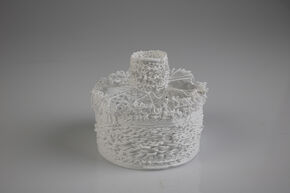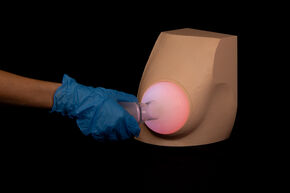TU/e to be represented at DDW after all
TU/e’s Drivers of Change exhibition at Dutch Design Week (DDW) will go ahead after all, albeit with a smaller exhibition. Despite a previous cancellation by project leader Lucas Asselbergs due to budget cuts, the exhibition will take place in October on Ketelhuisplein, with about a third of the exhibition space compared to previous years.
The new exhibition will be held in a 12-by-7.5-meter space of six connected containers. “All in all, we have about 15 projects and designs, about half of what we had last year,” says Asselbergs. These include a new 3D printer that allows the user to adjust the design during the printing process. “We also have a medical project in the form of a non-invasive breast cancer test and several AI applications will be presented.”
As in previous years, there will be plenty of room for student teams. Two cars will be on display: One made by student team TU/ecomotive, with all its components being fully recyclable or reusable, and a self-driving car built by University Racing Eindhoven. In addition, student team Serpentine AI will present a headset that allows users to control a cursor on a computer screen with their thoughts.
There is also a special place dedicated to semiconductors at the exhibition. “It’s not really a design, but we still want to give the audience an insight into how semiconductors enable advanced designs,” Asselbergs says. “Semiconductors are found in so many devices, and the university plays an important role in developing this technology. Seeing as we’re the ones bringing technical innovation to DDW, we felt it was an important topic to include.”
Text continues below photo.
Second thoughts
“Our vision was: we either do it well or not at all,” says project leader Lucas Asselbergs about his earlier decision to cancel Drivers of Change this year. “Such a project simply costs a lot of money and I was told fairly early on that we would only have half the budget available to organize it. A smaller exhibition wouldn’t be able to have the same impact as in past years.”
Despite his decision to stop the project, Asselbergs stayed in touch with the parties involved. During those meetings, the pressure to participate increased. For example, the Departments of Industrial Design and Architecture, Urbanism and Building Sciences pushed to continue with the exhibition. As time went on, Asselbergs grew more and more positive towards the idea. “The conclusion was that we simply had to be present at DDW. Particularly because our hard technology is of value during such a week. It’s a form of valorization, after all, creating impact.”
In practice, a smaller budget does not just mean a smaller exhibition. It also means Asselbergs and his team will have to take on more tasks. Tasks that would normally be outsourced. For example, no external production assistants, writers or translators will be hired, and hardly any guides. “It’s a way to reduce costs. It’s actually a fun challenge, to be honest. It forces you to think outside the box.” Drivers of Change also changed its exhibition designer.
Goal accomplished
Asselbergs is eager to see how the smaller exhibition will turn out. “It’s an experiment. It remains to be seen whether we can make enough of an impact with our new plan and will manage to stand out with a smaller exhibition in the already visually busy environment of Ketelhuisplein.” This is something the team behind Drivers Of Change will evaluate. “If we still manage to make an impact with this compact exhibition and spark good discussions among visitors and if we feel that this is an affordable and repeatable format, then we will have accomplished our goal.”





Discussion